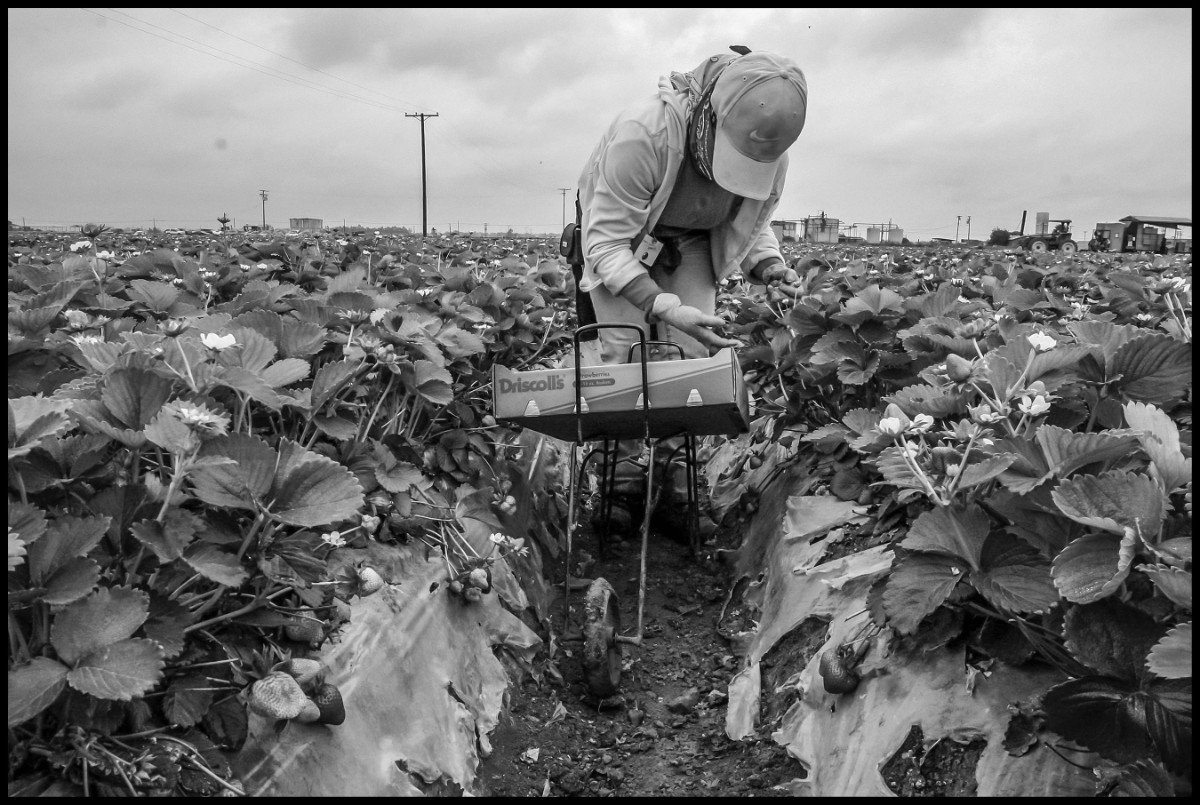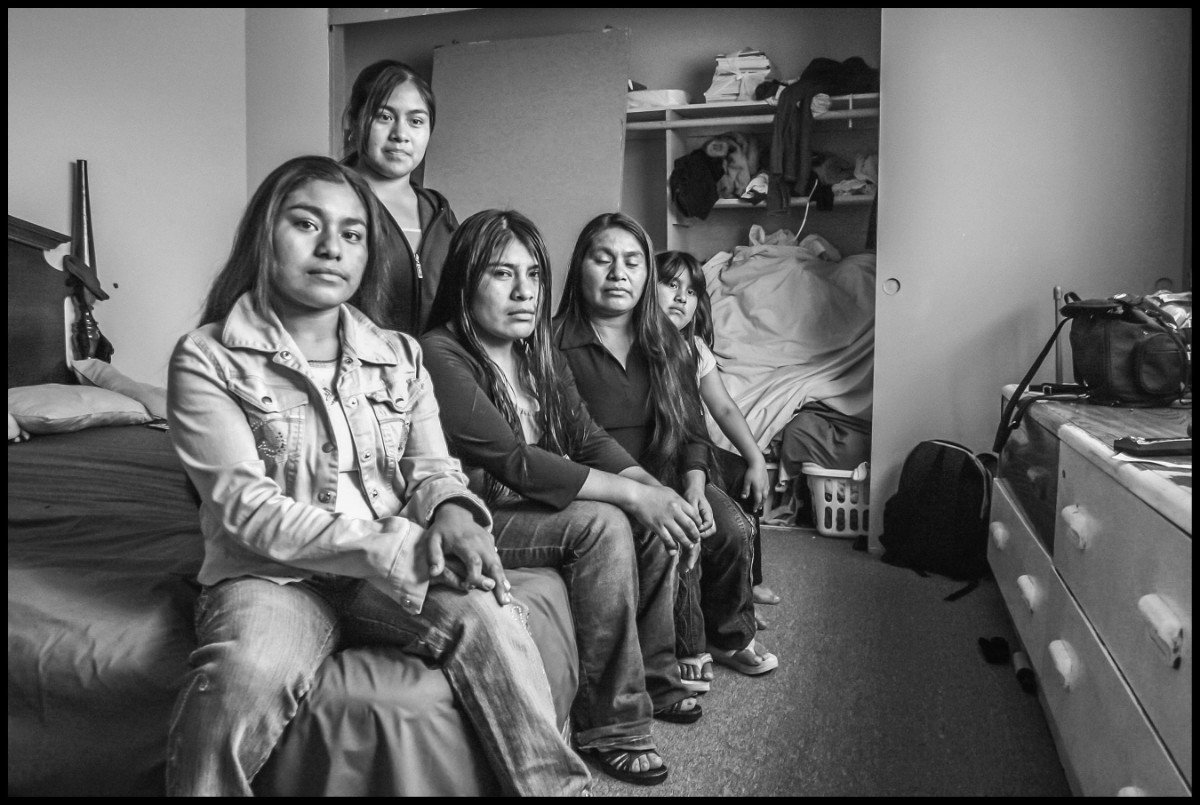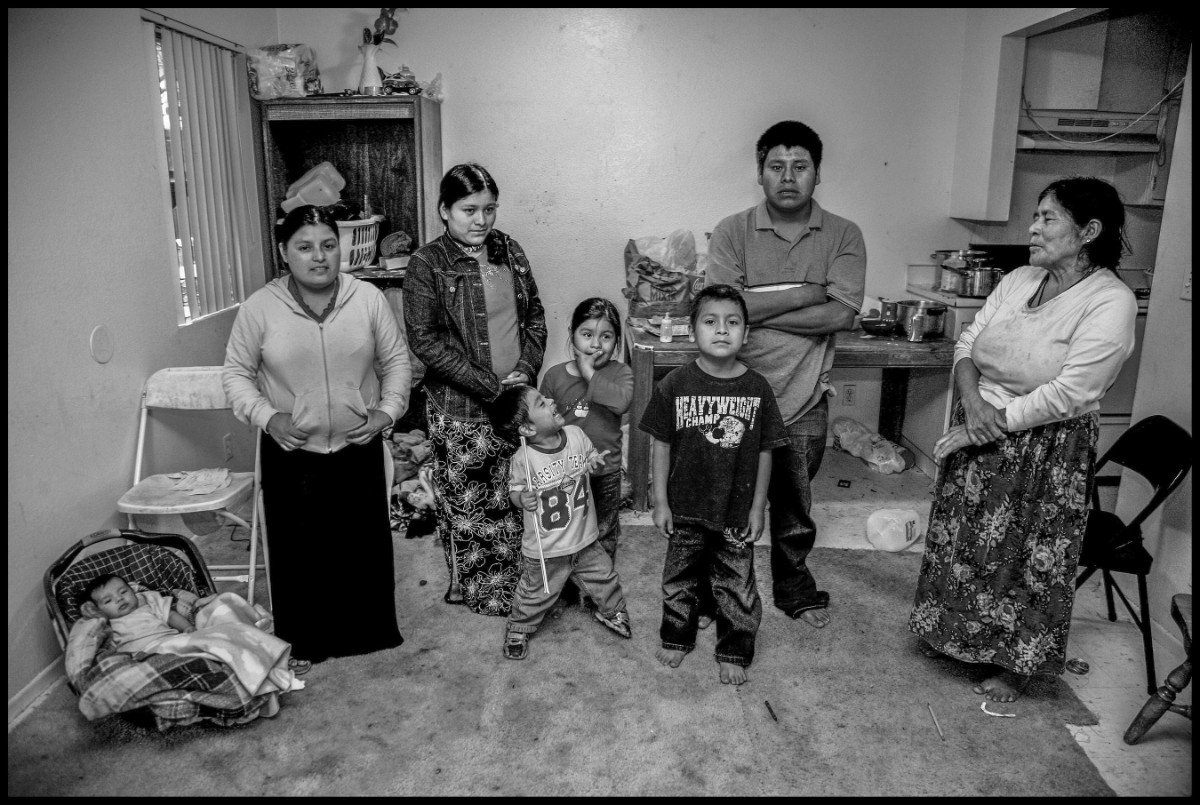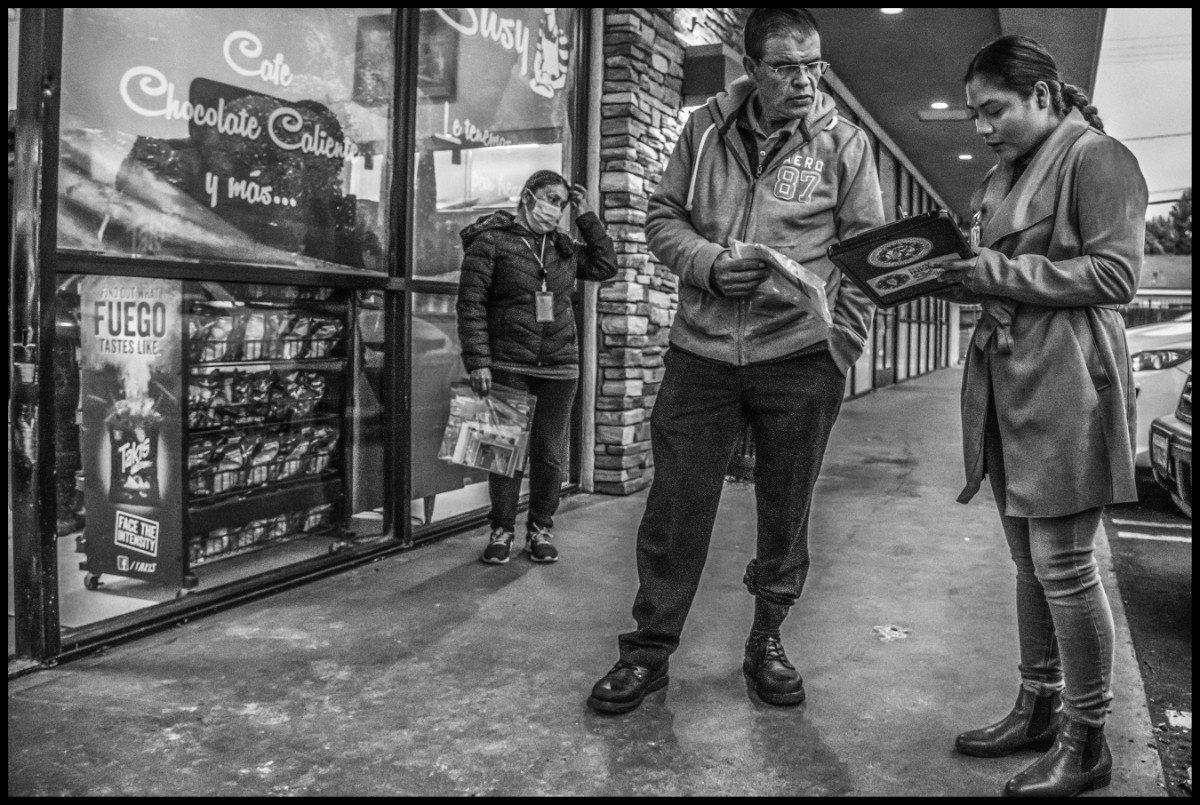Picking strawberries is one of the lowest-paid, most brutal jobs in agriculture. A new report argues for a better path forward that benefits everyone, including the growers.

Picking strawberries is one of the lowest-paid, most brutal jobs in agriculture. A new report argues for a better path forward that benefits everyone, including the growers.
April 24, 2024

A Mixtec immigrant from Oaxaca picks strawberries in Oxnard, Calif. She and her sister support three other family members, all of whom sleep and live in a single room in a house. (Photo © David Bacon)
Driving north from Santa Barbara on California’s Highway 101, you wind through miles of grapevines climbing gently rolling hills. It’s a bucolic vision of agriculture, with hardly a worker in sight.
As soon as you drop into the Santa Maria Valley, that vision changes. Here, from March through October, endless rows of strawberries fill the valley’s plain. Along the dirt access roads, cars sit parked in the dust, most of them older vans and sedans. Dozens of workers move down the rows.
You might notice tall plastic screens hiding some of the fields. Growers claim these screens keep animals out, but actually, they’re a legacy of the farmworker strikes of the 1970s, when growers sought to distance workers from strikers in the roadway calling out to them to stop picking and leave. The abusive and dangerous conditions of strawberry workers today, and their protests over them, make the screens more than just a symbol of past conflict.
Picking strawberries is one of the most brutal jobs in agriculture. A worker picking wine grapes can labor standing up. But the men and women in the strawberry rows have to bend double to reach the berries, in raised beds about a foot high, covered in plastic. The pain of this labor is a constant, and it’s worse at the beginning of the season. Workers will say you just have to get through the first week, when your back hurts so much you can’t sleep, until your body adjusts and the pain somehow gets less. In March, rain fills the rows with water and the cart must be dragged through the mud. When summer comes, the field turns into an oven by midday.
Through it all, workers have to pick as fast as possible, filling plastic clamshell containers—eight to a flat, the flat balanced on a cart they push between the rows. “It’s hard to pick even five boxes [flats] an hour, but if I can’t make that, or if I pick any green berries, it gets called to my attention,” said Matilde, a worker who didn’t want her last name used for fear of retaliation from her boss. She’d been picking for three weeks, her fifth year in the strawberry fields. “The foreman tells us we’re not trying hard enough, that they don’t have time to teach us, and if we can’t make it we won’t keep working. Some are even fired there in the field.”
“Not many people can do this job,” said Matilde’s coworker Juana, who also did not want her last name disclosed. Juana came to the Santa Maria Valley from the village of Santiago Tilantongo, in the Mexican state of Oaxaca. Like many strawberry pickers here, she speaks Mixtec—one of many Indigenous languages in southern Mexico—in addition to Spanish. She’s been a strawberry worker for 15 years. “I have permanent pain in my lower back,” she said, “and when it rains it gets very intense. Still, I get up every morning at 4, make lunch for my family, and go to work. It’s a sacrifice, but it’s the only job I can get.”
On April 1, the Alianza Campesina de la Costa Central (Farmworker Alliance of the Central Coast) held a press conference in the city of Santa Maria. The alliance, formed by the Mixteco/Indigena Community Organizing Project (MICOP) and the Central Coast Alliance United for a Sustainable Economy (CAUSE), announced their new report on the harsh working conditions and low wages that are the norm for farmworkers in the region and across the country. A powerful, 44-page document, Harvesting Dignity: The Case for a Living Wage for Farmworkers documents in shocking statistics what Matilde and Juana know from personal experience.
The report cited the Massachusetts Institute of Technology’s living wage calculation for Santa Barbara County, one of the most expensive places to live in the United States, at $36.53 per hour apiece for two working parents with two children. Total income required for all basic expenses: $99,278.
Juana and Matilde, both working parents with children at home—Juana three, Matilde two—made less than half of the MIT calculation: $16 an hour, the state minimum wage. That would translate to a yearly income for each of $32,640.
Because strawberries are only in season for eight months, though, the women’s annual income was actually much lower. Full-time work at minimum wage for eight months would earn them $21,760. But at the beginning of the season, with not enough berries for eight hours of work each day, Matilde only got 36 hours a week—even working on Saturdays too. Juana’s week was 15 to 20 hours.
At the height of the season, instead of paying by the hour, growers begin to pay a piece rate of up to $2.20 per flat. To make the equivalent of the minimum wage, a worker has to pick more than seven flats an hour, and can earn more—but that means working like a demon, ignoring the physical cost. “Champion pickers can do eight or nine an hour,” Matilde said. “But not everyone can. Six or seven is normal.”
Most of the county’s farmworkers live in the city of Santa Maria, where the median rent is about $3,000 per month. Because of the high cost of living, a quarter of all California farmworkers sleep in a room with three or more people, according to a UC Merced/California Department of Public Health survey quoted in the report.

The Diaz family, Mixtec immigrants from Oaxaca, sleep and live in a single room in a house in Oxnard, where other migrant families also live. The Diaz family are strawberry workers. From the left, Guillermina Ortiz Diaz, Graciela, Eliadora, their mother Bernardina Diaz Martinez, and little sister Ana Lilia. (Photo © David Bacon)
Out of her strawberry wages, Juana and her husband, who works in the field with her, are paying $2,000 a month for rent, or $24,000 a year. While three of her children are grown, the other three are still at home. “We have to save to pay the rent during the winter when there’s no work. If we don’t, we don’t have a place to live,” she explained. “There are always bills we can’t pay, like water. By March there’s no money at all, and we have to get loans to survive.”
The loans, she said, come from “friends” who charge 10 percent interest. “Plus, I have to send money to my mama and papa in Mexico. There are many people depending on me.”
Matilde and her husband and their two children share a bedroom in a two-bedroom house. A family of three lives in the other bedroom, and together they pay $2,200 in rent.
“Fortunately, my husband works construction and gets $20 an hour, but the same months when there are no strawberries, the rain cuts his hours too,” she said. “Often there’s just enough money for food. We don’t eat beef or fish, just economical foods like pasta, rice, and beans. And even with that, sometimes we have to get a loan too.”

In the spring and summer a Mixtec family, living in an apartment complex in Santa Maria, works picking strawberries. Leobarda Hernandez, her daughter Rosa Seferino, and their children Carolina, Michael, Elena, Porfirio and Jorge Garcia. (Photo © David Bacon)
This poverty affects all farmworkers in the state, in all aspects of life. Only about half of farmworkers surveyed have health insurance, an unaffordable luxury. That number drops further for undocumented workers, to less than a quarter.
Because reporting bad conditions—and even more so, protesting them—is much riskier for undocumented workers, having no papers affects survival at work as well. “In Santa Barbara County in 2023 there were two farmworker deaths, both related to poor supervision and training of agricultural equipment usage,” the report noted. “In one instance, farmworkers reported they were told to continue working in a Cuyama carrot field alongside the body of their fallen coworker.”
Santa Maria strawberry workers have repeatedly protested this unfair system. In 1997, a Mixteco worker group organized a strike that stopped the harvest on all the valley’s ranches, which lasted three days.
More recently, workers at Rancho Laguna Farms protested the owner’s failure to follow CDC guidelines during the pandemic, and won a 20-cent-per-box raise by stopping work. In 2021, 40 pickers at Hill Top Produce used the same tactic to raise the per-box piece rate from $1.80 to $2.10, which was followed by similar action by 150 pickers at West Coast Berry Farms. At the beginning of the next season in 2022 work stopped at J&G Berry Farms in another wage protest.
“During the pandemic, these workers provided our food, even though as consumers we can be oblivious of that fact,” said Erica Diaz Cervantes, an author of the Harvesting Dignity report and senior policy advocate at Central Coast Alliance United for a Sustainable Economy (CAUSE). “When the workers have initiated these strikes, it has put more attention on their situation.”
Last year, workers carried out a dramatic and well-organized strike at Wish Farms, a large berry grower with fields in Santa Maria and Lompoc, and headquarters in Florida. The story of the strike, and its aftermath, is a case study in the multiple challenges workers face in their struggle for justice.
Left: Strawberry workers on strike at Wish Farms call out to workers to leave the field and join them. Right Strawberry workers at Wish Farms hold a meeting at the edge of the field and decide to form an organization, Freseros Unidos por la Justicia, or Strawberry Workers United for Justice. (Photos © David Bacon)
At the height of the season, to increase production, the company promised a wage of $6 per hour plus $2.50 per box, a rate they’d paid the previous year. When workers saw their checks, however, the piece-rate bonus was a dollar less.
They met with Fernando Martinez, an organizer with MICOP. Martinez and MICOP organizers had helped workers during the earlier work stoppages, and urged the Wish Farms strikers to go out to the fields to call other workers to join. “We helped them form a committee,” Martinez said, “and in a meeting at the edge of the field, they voted to form a permanent organization, Freseros por la Justicia [Strawberry Workers for Justice].”
Workers say that after they walked out, the company brought a crew with H-2A guestworker visas into one of the fields to replace them. The H-2A program allows growers to import workers from Mexico and other countries for less than a year, after which they have to return home.
Replacing domestic workers with H-2A workers during a labor dispute is a violation of Federal regulations. Wish Farms did not respond to requests for comment about the strike.
During the walkout, Concepcion Chavez, one of the strikers, told me, “We are always afraid they’ll replace us, because they give a preference to the contratados [H-2A workers]. That’s what the supervisors say, that they’ll replace us and send in the contratados.”
After two days, strikers reached an agreement with Wish Farms and went back to work. In September, however, as the work slowed for the winter, Chavez asked if she would be hired again the following season. “In the office they told me they had no job because the company was already filled up,” she recalled. “But when I went back to my foreman, he said the company had told him not to give me a job. That happened to other workers who were in the strike too.”
Martinez pointed out an additional obstacle that farmworkers face. After strikes, he said, “workers usually don’t want to continue organizing because the company brings in anti-union consultants.” Wish Farms brought in Raul Calvo, a man with a long history as a union buster.
At the Apio/Curation Foods processing facility in Guadalupe, a few miles from Santa Maria, Calvo was paid more than $2 million over eight years to convince workers not to organize with the United Food and Commercial Workers. After the union was defeated in 2015, Curation Foods was bought by ag giant Taylor Farms for $73 million.
Following huge wildfires in 2017, Calvo appeared in Sonoma County in 2022 to thwart proposals for worker protections in vineyards. He organized a committee of pro-grower workers, who testified at hearings in opposition. (An ordinance including some of the protections was finally passed by the county Board of Supervisors later that year.) Most recently, Calvo was hired by the Wonderful Company to organize another anti-union committee to oppose nursery workers in Wasco, CA, who are trying to join the United Farm Workers.
This kind of opposition to unions and worker organizing activity is one reason why strawberry wages remain close to the legal minimum, said Diaz Cervantes. “[Workers] win small improvements and wins, but always in the piece rate, never the basic hourly wage. And the actions don’t go on longer because workers can’t afford to.” The net result: no permanent worker organizations.
Immigration status also plays a role in low wages. “Eighty percent of farmworkers in Santa Maria are undocumented, and without them there is no agriculture,” said Jamshid Damooei, professor and director of the economics program at California Lutheran University and a principal advisor for the report. “Yet the median wage, which in 2019 was $26,000 a year for farmworkers born in the U.S, was only $13,000—half that—for the undocumented.”
Even though undocumented labor is cheap, strawberry growers in Santa Maria increasingly use the H-2A program to bring in workers from Mexico and Central America. Last year, the Department of Labor gave growers permission to bring 371,619 of these workers, about a sixth of the entire U.S. farm labor workforce. Growers provide food and housing. Because employment is limited to less than a year, workers must apply to recruiters to return each year.
Growers say labor shortages make hiring H-2A workers necessary. According to Western Growers president and CEO Tom Nassif, “Farmers in all sectors of U.S. agriculture, especially in the labor-intensive fruit and vegetable industries, are experiencing chronic labor shortages, which have been exacerbated by recent interior immigration enforcement and tighter border security policies.”
That is not the case, at least in the Santa Maria Valley, Diaz Cervantes responded. She says the 2022 census reported 12,000 workers there. Fernando Martinez believes the true number is double that. “I do not think there’s a shortage of farmworkers here,” Diaz Cervantes continued. “We know it’s a lot more, because many undocumented people are afraid to be counted. There are always people ready to work and put in more hours. It’s just a way to justify increasing the H-2A program.”
H-2A workers themselves are often not treated fairly. Almost all are young men. The program has a long record of complaints of overcrowding, substandard conditions, and enforced isolation from the surrounding community. Workers who aren’t fast enough, or who protest their living quarters or limited mobility (for activities like grocery shopping), can be fired at any time and sent back. Federal regulations establish a wage for them, which last year in California was $18.65 per hour—no unemployment or disability, saving growers that cost. Many H-2A workers report not being paid what they were promised, according to the Harvesting Dignity report.
Left: This complex was listed as the housing for 160 workers by Big F Company, Inc. and Savino Farms. It was formerly senior housing, and the contractor built a wall around it, with a gate controlling who enters and leaves. Center: Bars on the windows of the same complex. Right: This trailer was listed as the housing for six workers by La Fuente Farming, Inc. (Photos © David Bacon)
Last September at Sierra del Tigre Farms, in Santa Maria, more than 100 workers were terminated before their contracts had ended and told to go back to Mexico. The company then refused to pay them the legally required wages they would have earned.
One worker, Felipe Ramos, was owed more than $2,600. “It was very hard,” he remembers. “I have a wife and baby girl, and they survive because I send money home every week. The company had problems finding buyers, and too many workers.” In March Sierra del Tigre Farms declared bankruptcy, still owing workers their wages. Last year Rancho Nuevo Harvesting, Inc., a labor contractor, was forced by the Department of Labor to pay $1 million in penalties and back wages to H-2A workers it had cheated in a similar case.
“The H-2A program should be phased out . . . . We should not become a democracy that is half slave and half free.”
Rick Mines, a statistician who designed the original National Agricultural Workers Survey for the U.S. Department of Labor, is unsparing in his criticism of the H-2A program and its effect on both H-2A and domestic workers here. “There are about 2 million farmworkers in the U.S., mostly immigrant men and women who live as families with U.S.- born children. They are being displaced by a cheaper, more docile labor force of single male H-2A workers.
“The H-2A program should be phased out and replaced with a program of legal entry for immigrants who can bring their families and eventually become equal American citizens. We should not become a democracy that is half slave and half free.”
As the strawberry season unfolds in Santa Maria, growers will feel increasing pressure to get the ripe berries from the fields to supermarket shelves. Juana and Matilde will need the work to pay past bills and hopefully save for future ones. The Alianza Campesina’s support could have a big impact on their wages and lives.
“Perhaps there are different ways to change things,” speculated Martinez, the community organizer. “We’ve thought about a local ordinance like ones we’ve seen for other kinds of workers,” he continues, referencing hotel workers and fast-food workers in the state. He hasn’t lost hope that unionizing might be possible someday. “A union could also raise pay and bring benefits and holidays.”

Alondra Mendoza, a community outreach worker for MICOP, talks with a farmworker outside the Panaderia Susy early in the morning before work. (Photo © David Bacon)
MICOP and CAUSA are holding house meetings with small groups of workers and a general meeting every two weeks. “Right now we’re trying to popularize the idea of a sueldo digno [dignified wage] and explain the justice of this demand,” Martinez said. “The idea is to increase workers’ knowledge. And since so many of us are Mixtecos, we’re getting workers to reach out to their workmates from the same home communities in Oaxaca.”
Matilde has already made up her mind to get involved.
“Why should we get $2 or $2.20 per box when $3 or $3.50 is what’s fair? People have to unite—and we need big demonstrations. It’s necessary to pressure the ranchers so they value our work. Without us they have nothing. We do all the work. I am willing to help organize this, because it will make life a lot better. I hope it will happen soon.”
Correction: This article was updated to correct the location to the Santa Maria Valley, not the Santa Ynez Valley. We apologize for the error.

October 9, 2024
In this week’s Field Report, MAHA lands on Capitol Hill, climate-friendly farm funding, and more.
October 2, 2024

October 2, 2024

October 1, 2024

September 30, 2024

September 25, 2024

September 25, 2024

The farmer kept us far away from the migrant farmworkers. We were working for spending money; they were making their living. I felt the gravity of that even as a child. We would leave the fields on busses around 2 p.m., but the migrant workers stayed. Their entire families worked, even the little kids.
I always think of the people who pick my strawberries (and harvest other produce) and send a prayer for their safety and gratitude for their difficult work. I hope they succeed in getting paid a decent, dignified wage ASAP.